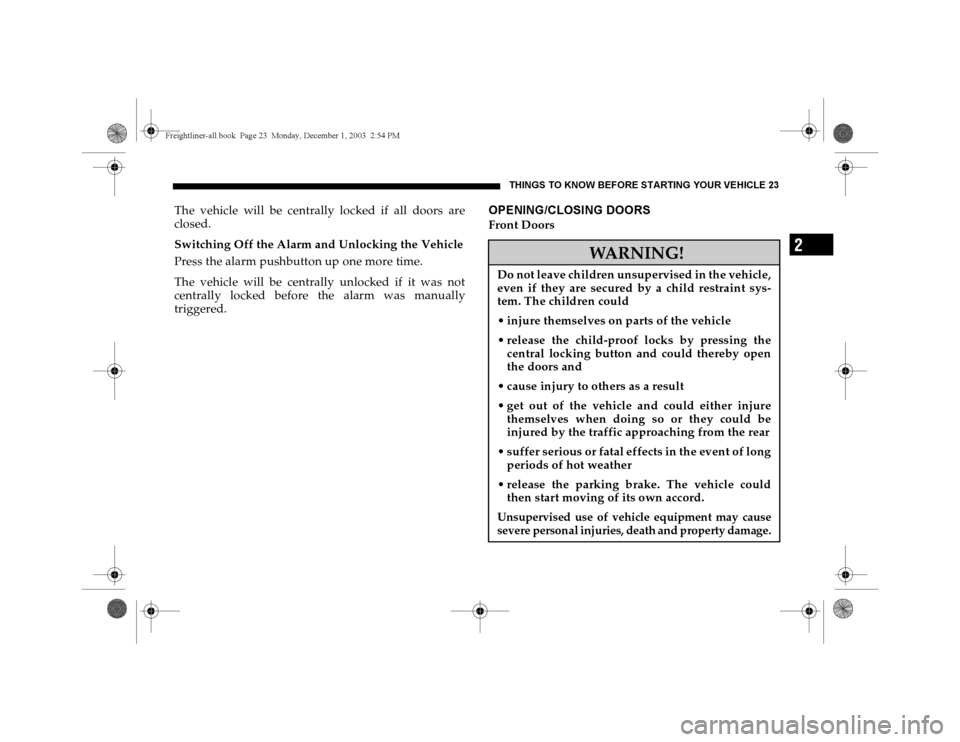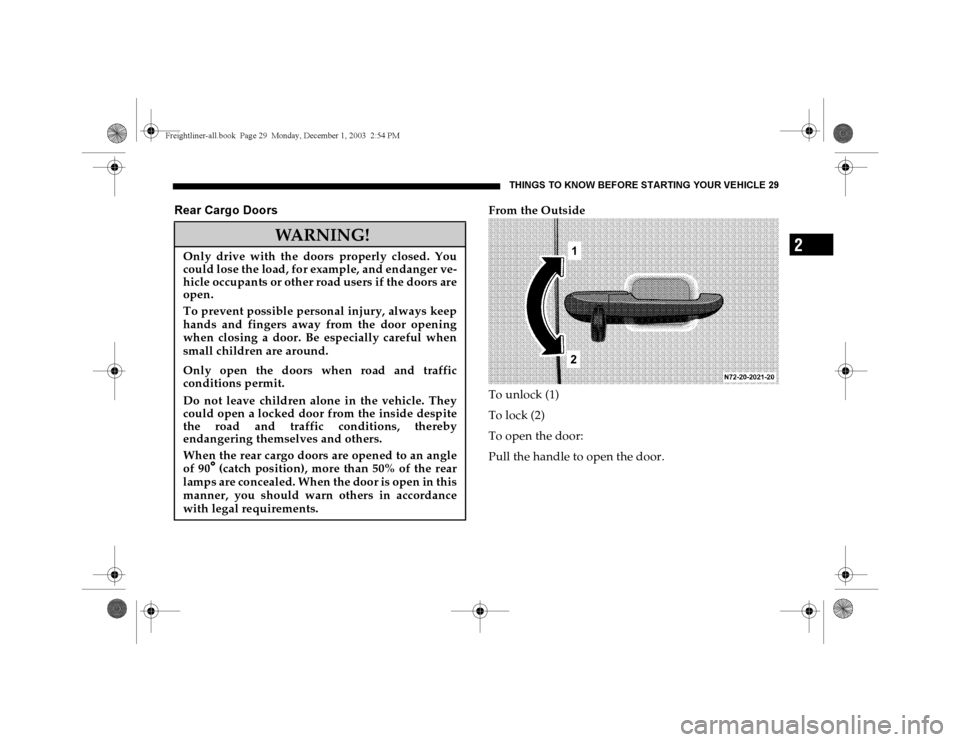Page 18 of 272

18 THINGS TO KNOW BEFORE STARTING YOUR VEH ICLEPress the Πbutton a second time. The passenger
door and cargo doors are unlocked and the turn signal
lamps, as well as the remote keyless entry transmitter
indicator lamp, blink once again. The button must be
pressed a second time within about 2.5 seconds,
otherwise the second request to open can not be
performed.
NOTE: The vehicle is automatically locked again, if
within about 40 seconds of unlocking with the remote
keyless entry transmitter, none of the doors are
opened. The hazard warning lamp does not blink.Locking with Remote Keyless EntryPress the ‹ button. The entire vehicle is locked and
the hazard warning lamp blinks three times. The
remote keyless entry transmitter indicator lamp blinks
once.
If the hazard warning lamp does not blink, at least one
door is improperly closed. Check to see if there is a
door that is not properly closed or if there is a key in the
ignition lock. Remove key from ignition lock and/or
close doors properly and press the ‹ button again.
REPLA CING BA TTERIES IN REMOTE KEYLESS
ENTRYDo not touch the battery contact surfaces (insert the
batteries with a lint-free cloth).
NOTE: Do not operate the remote control while the
battery is being replaced.
WARNING!
Keep batteries away from children.
Consult a doctor immediately if a battery is
swallowed.
Dispose of used batteries in an environmentally
responsible manner.
Danger of explosion if the battery is not correctly
replaced. Replacements should always be either
of the same type or one which has been
recommended by the manufacturer.
Freightliner-all.book Pag e 18 Monday , December 1, 2003 2:54 PM
Page 23 of 272

THINGS TO KNOW BEFORE STARTING YOUR VEHICLE 23
2
The vehicle will be centrally locked if all doors are
closed.
Switching Off the Alarm and Unlocking the Vehicle
Press the alarm pushbutton up one more time.
The vehicle will be centrally unlocked if it was not
centrally locked before the alarm was manually
triggered.
OPENING/CLOSING DOORSFront Doors
WARNING!
Do not leave children unsupervised in the vehicle,
even if they are secured by a child restraint sys-
tem. The children could
injure themselves on parts of the vehicle
release the child-proof locks by pressing the
central locking button and could thereby open
the doors and
cause injury to others as a result
get out of the vehicle and could either injure
themselves when doing so or they could be
injured by the traffic approaching from the rear
suffer serious or fatal effects in the event of long
periods of hot weather
release the parking brake. The vehicle could
then start moving of its own accord.Unsupervised use of vehicle equipment may cause
severe personal injuries, death and property damage.
Freightliner-all.book Pag e 23 Monday , December 1, 2003 2:54 PM
Page 24 of 272
24 THINGS TO KNOW BEFORE STARTING YOUR VEH ICLE
From the Outside
To unlock (1)
To lock (2)
To open the door:
Pull the handle to open the door.
WARNING!
Only drive with the doors properly closed. You
could lose the load, for example, and endanger ve-
hicle occupants or other road users if the doors are
open.
Only open the doors when road and traffic
conditions permit.
Do not leave children alone in the vehicle. They
could open a locked door from the inside despite
the road and traffic conditions, thereby
endangering themselves and others.
To prevent severe personal injuries and death,
always keep hands and fingers away from the
door opening when closing a door. Be especially
careful when small children are around.
Freightliner-all.book Pag e 24 Monday , December 1, 2003 2:54 PM
Page 26 of 272

26 THINGS TO KNOW BEFORE STARTING YOUR VEH ICLESliding Door
From the Outside
To unlock (1)
To lock (2)
To open the door:
Pull the handle and slide the door back to the stop.
To close the door:
Slide it forwards by the handle until it latches.
WARNING!
Only drive with the doors properly closed. You
could lose the load, for example, and endanger ve-
hicle occupants or other road users if the doors are
open.
To prevent possible personal injury, always keep
hands and fingers away from the door opening
when closing a door. Be especially careful when
small children are around.
Only open the doors when road and traffic
conditions permit.
Do not leave children alone in the vehicle. They
could open a locked door from the inside despite
the road and traffic conditions, thereby
endangering themselves and others.
Do not leave doors open on uphill or downhill
grades. Doors could be released from the door
support and slam shut. If they are not closed
properly, sliding doors can open on their own.
This could result in severe injury. Be especially
careful when small children are around.
Freightliner-all.book Pag e 26 Monday , December 1, 2003 2:54 PM
Page 29 of 272

THINGS TO KNOW BEFORE STARTING YOUR VEHICLE 29
2
Rear Cargo Doors
From the Outside
To unlock (1)
To lock (2)
To open the door:
Pull the handle to open the door.
WARNING!
Only drive with the doors properly closed. You
could lose the load, for example, and endanger ve-
hicle occupants or other road users if the doors are
open.
To prevent possible personal injury, always keep
hands and fingers away from the door opening
when closing a door. Be especially careful when
small children are around.
Only open the doors when road and traffic
conditions permit.
Do not leave children alone in the vehicle. They
could open a locked door from the inside despite
the road and traffic conditions, thereby
endangering themselves and others.
When the rear cargo doors are opened to an angle
of 90
° (catch position), more than 50% of the rear
lamps are concealed. When the door is open in this
manner, you should warn others in accordance
with legal requirements.
Freightliner-all.book Pag e 29 Monday , December 1, 2003 2:54 PM
Page 33 of 272
THINGS TO KNOW BEFORE STARTING YOUR VEHICLE 33
2
To close:
Pull the doors away from the retaining plates on the
outer sidewalls.
Passenger/Cargo A rea DoorNOTE: The maximum cargo area door height is 5 feet
7 inches (176 cm).
WARNING!
Always drive with the doors properly closed, be-
cause if the vehicle is operated with the doors
open, serious personal injury may result.
To prevent possible personal injury, always keep
hands and fingers away from the door opening
when closing a door. Be especially careful when
small children are around.
Freightliner-all.book Pag e 33 Monday , December 1, 2003 2:54 PM
Page 35 of 272

THINGS TO KNOW BEFORE STARTING YOUR VEHICLE 35
2
OCCUPA NT RESTRA INTSSeat belts, belt tensioners, airbag and child restraint
systems are independent restraint systems whose
functions complement each other.
All states and provinces require use of child restraints
that comply with U.S. Federal Motor Vehicle Safety
Standard 213 and Canadian Motor Vehicle Safety
Standard 213.
All child restraint systems are designed to be secured
in vehicle seats by lap belts or the lap belt portion of a
lap-shoulder belt.
For your safety and that of your passengers, you must
use the seat belts and child restraint systems and use
them properly. We strongly recommend their use.
WARNING!
In a collision, you and your passengers can suffer
injuries, including fatalities, if you are not proper-
ly buckled up. You can strike the interior of your
vehicle or other passengers, or you can be thrown
out of the vehicle. Always be sure you and others
in your vehicle are buckled up properly.
WARNING!
An airbag system component integrated in the
steering wheel gets hot after the airbag has inflat-
ed. Do not touch.
No modifications of any kind may be made to any
components or wiring of the restraint system.
Keep area between airbag and occupants free of
objects (e.g. packages, purses, umbrellas, etc.).
In addition, through improper work there is the
risk of rendering the restraint system inoperative.
Work on the restraint system must therefore only
be performed by an authorized Sprinter Dealer.
When discarding of the airbag unit or emergency
tensioning retractor, you must follow our safety
instructions. These instructions are available at
your Sprinter Dealer.
Given the considerable deployment speed and the
textile structure of the airbag, there is the
possibility of injuries and even death resulting
from being positioned too close to the airbag
when it deploys.
Freightliner-all.book Pag e 35 Monday , December 1, 2003 2:54 PM
Page 37 of 272

THINGS TO KNOW BEFORE STARTING YOUR VEHICLE 37
2
SEAT BELTS
WARNING!
Wearing a seat belt incorrectly is dangerous.
Seat belts are designed to go around the large
bones of your body. These are the strongest
parts of your body and can take the forces of a
collision the best. Wearing your belt in the
wrong place could make your injuries in a colli-
sion much worse. You might suffer internal in-
juries, or you could even slide out of part of the
belt. Follow these instructions to wear your seat
belt safely and to keep your passengers safe, too.
Two people should never be belted into a single
seat belt. People belted together can crash into
one another in an accident, hurting one another
badly. Never use a lap/shoulder belt or a lap belt
for more than one person, no matter what their
size.
WARNING!
A belt that is buckled into the wrong buckle will
not protect you properly. The lap portion could
ride too high on your body, possibly causing inju-
ries. Always buckle your belt into the buckle near-
est you.
A belt that is too loose will not protect you as well.
In a sudden stop you could move too far forward,
increasing the possibility of injury. Wear your
seat belt snugly.
A belt that is worn under your arm is very
dangerous. Your body could strike the inside
surfaces of the vehicle in a collision, increasing
head and neck injury. A belt worn under the arm
can cause internal injuries. Ribs aren’t as strong as
shoulder bones. Wear the belt over your shoulder
so that your strongest bones will take the force in
a collision.
A shoulder belt placed behind you will not protect
you from injury during a collision. You are more
likely to hit your head in a collision if you do not
wear your shoulder belt. The lap and shoulder
belt are meant to be used together.
Freightliner-all.book Pag e 37 Monday , December 1, 2003 2:54 PM